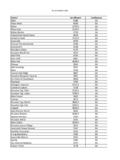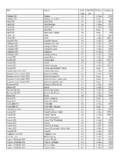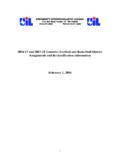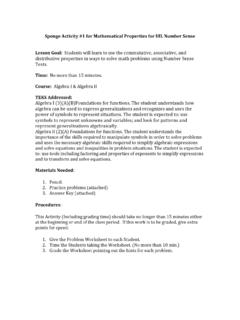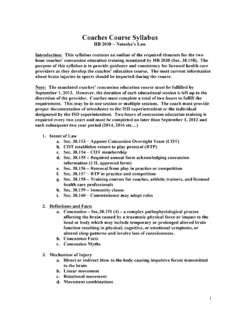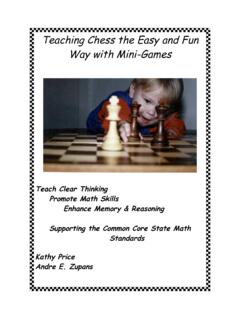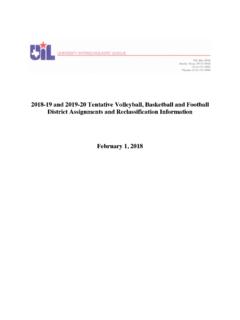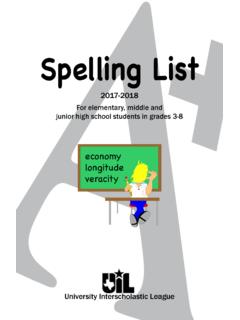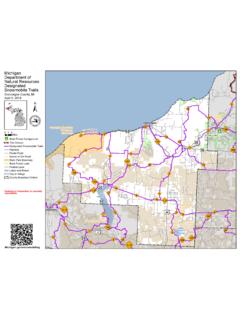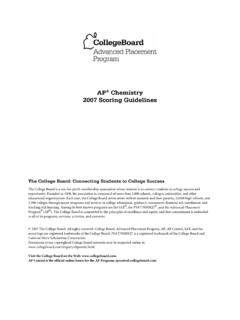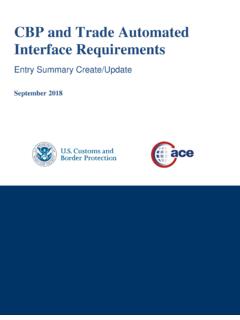Transcription of Chemical Kinetics: A Laboratory Investigation of Rate Laws
1 Chemistry Lesson to Prepare for UIL Science Contest Lesson Plan Title: Chemical kinetics : A Laboratory Investigation of Rate Laws Goal of Lesson: To use actual Laboratory data to determine a rate law, rate constant, and activation energy through application of the related mathematical relationships studied in class. Subject/Grade Level: chemistry (preAP/AP) TEKS Addressed: (1) Scientific processes. The student, for at least 40% of instructional time, conducts Laboratory and field investigations using safe, environmentally appropriate, and ethical practices. The student is expected to: (A) demonstrate safe practices during Laboratory and field investigations, including the appropriate use of safety showers, eyewash fountains, safety goggles, and fire extinguishers; (B) know specific hazards of Chemical substances such as flammability, corrosiveness, and radioactivity as summarized on the Material Safety Data Sheets (MSDS); and (C) demonstrate an understanding of the use and conservation of resources and the proper disposal or recycling of materials.
2 (2) Scientific processes. The student uses scientific methods to solve investigative questions. The student is expected to: (E) plan and implement investigative procedures, including asking questions, formulating testable hypotheses, and selecting equipment and technology, including graphing calculators, computers and probes, sufficient scientific glassware such as beakers, Erlenmeyer flasks, pipettes, graduated cylinders, volumetric flasks, safety goggles, and burettes, electronic balances, and an adequate supply of consumable chemicals; (F) collect data and make measurements with accuracy and precision; (G) express and manipulate Chemical quantities using scientific conventions and mathematical procedures, including dimensional analysis, scientific notation, and significant figures; (H) organize, analyze, evaluate, make inferences, and predict trends from data.
3 And (I) communicate valid conclusions supported by the data through methods such as lab reports, labeled drawings, graphs, journals, summaries, oral reports, and technology-based reports. (10) Science concepts. The student understands and can apply the factors that influence the behavior of solutions. The student is expected to: (C) calculate the concentration of solutions in units of molarity; (D) use molarity to calculate the dilutions of solutions. Overview of Lesson: Students will determine the rate law, rate constant, and activation energy for the iodination of acetone through Laboratory experiment. Materials Needed: 1. Laboratory supplies for the attached Investigation 2. Scientific or graphing calculator 3. Textbook or internet resources on Chemical kinetics Procedures and Activities: The teacher will - present a lesson cycle on Chemical kinetics including rate laws, orders of reaction, rate constants, and the Arrhenius equation prior to this activity.
4 Provide students problem solving practice and feedback on Chemical kinetics . prepare necessary solutions and equipment for the lab procedure. (The iodination of acetone lab is found in many college lab manuals as well as on numerous internet sites. One version of this lab is attached.) review students on the concept of molarity and finding molarity by dilution as this is necessary for determining the starting concentrations of reactants in this experiment. Independent Practice: The student will complete the Laboratory Investigation prepare a formal lab report Assessment: Teacher evaluation of lab report. IODINATION OF ACETONE The rate at which a Chemical reaction occurs depends on several factors: the nature of the reaction, the concentrations of the reactants, the temperature, the surface area (particle size) of solid reactants, and the presence of possible catalysts or inhibitors.
5 This experiment involves a study of the kinetics of the reaction between iodine and acetone: CH3 COCH3 + I2 CH3 COCH2I + H+ + I- The reaction rate is rather slow for a pH range of 4 to 8, but the rate is rather rapid for a pH less than 3 or greater than 8. The rate of this reaction is therefore dependent on the concentration of hydrogen ion in the solution as well as presumably on the concentration of the two reactants, acetone and iodine. The generic rate law for this reaction can be written: Rate = k[acetone]m[I2]n[H+]p Where m, n, and p are the orders of the reaction with respect to acetone, iodine, and hydrogen ion, respectively, and k is the rate constant for the reaction. This reaction is rather easy to study because the reactant iodine has a distinctive pigment while the iodide ion produced is colorless.
6 The rate of this reaction can be expressed as the change in the concentration of iodine over time, or simply, the starting concentration of iodine in the solution divided by the amount of time it takes for the iodine to disappear and the solution turn colorless. It is also known that the rate is independent of the concentration of iodine as long as iodine is present, or zero order in iodine. The procedure is designed to have iodine as a limiting reactant, with both the hydrogen ion and the acetone at much higher concentrations so that their own concentrations do not change appreciably during the course of the reaction. The rate of the reaction will then be: The orders of reaction with respect to hydrogen ion and acetone can be analyzed by varying their concentrations and determining the rate of reaction.
7 In a second part of the experiment, the reactant temperature will be changed while keeping the reactant concentrations constant. Measuring the rate will then permit calculation of the activation energy of the reaction using the Arrhenius equation. EXPERIMENTAL PROCEDURE: Be sure to wear apron and safety goggles throughout the experiment and follow all disposal procedures set by your instructor. A. Determine the rate law Using either a graduated cylinder or measuring pipet, accurately measure out mL of M acetone into a clean, dry 100-mL beaker. Using a different graduated cylinder or pipet, measure out mL of M HCl and add it to the acetone in the beaker. Add mL of distilled water to the beaker and mix. Using a different graduated cylinder or pipet, measure out mL of the M I2 solution.
8 Have a stopwatch ready and begin timing as soon as the iodine solution is added to the 100-mL beaker. Quickly swirl the solution to mix the reactants. The mixture will appear yellow due to the iodine present. The color will fade as the iodine is reacting and becoming iodide ion. Stop timing when the color of the iodine just disappears. Repeat the experiment. Perform the experiment three more times (two trials for each), following the chart provided in data table A. Note that each experiment has varying volumes of reactants. Data Table A Experiment M acetone (mL) M HCl (mL) M iodine (mL) Distilled water (mL) Time trial A (s) Time trial B (s) Average Time (s) 1 2 3 4 Calculations Part A Find the concentration of each reactant for each experiment.
9 Remember that the total volume of the reaction mixture is mL. Find the rate of each experiment using [I2]o/t. Determine the rate law for the reaction. B. Determine the Activation Energy Using clean graduated cylinders or pipets for each solution, combine mL distilled water, mL M acetone, and mL M HCl in a large test tube. Measure out mL of M I2 into a separate test tube. Place a thermometer into the large test tube measure the temperature of the reaction mixture. Prepare a stop watch and begin timing when the iodine is added to the large test tube reaction mixture. Record the time when the color just disappears. Repeat the process an additional temperature by placing the test tubes into a water bath and letting them reach the desired temperature before starting the reaction.
10 (Recommend about 15 C to about 35 C range) Data Table B Temperature Time (s) Calculations Part B Find the concentration of each reactant for this experiment. Remember that the total volume of the reaction mixture is mL and that the concentrations are constant for both temperatures. Find the rate of each experiment using [I2]o/t. (The rates should be different for each temperature.) Using the rate law determined in part A, determine the rate constant (k) for each temperature. Determine the activation energy using the Arrhenius Equation. Chemistry Lesson to Prepare for UIL Science Contest Lesson Plan Title: Modeling Molecular Geometry Goal of Lesson: To apply the VSEPR theory of molecular geometry. Subject/Grade Level: chemistry (esp. Pre-AP & AP) TEKS Addressed: (6) Science concepts.
